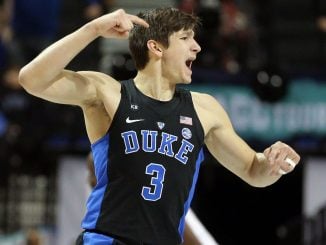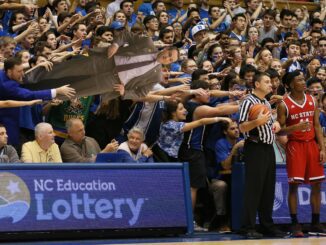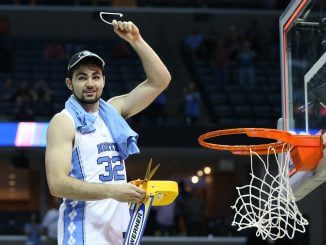
In 2005, longtime UNC writer Art Chansky wrote the definitive history of the UNC-Duke basketball rivalry, “Blue Blood.” Chansky, whose then-three decades of experience with the rivalry, dating back to his days with the Daily Tar Heel, provided a thoroughly researched look into the best rivalry in sports, filled with colorful quotes and anecdotes from the participants.
That was 13 years ago. A lot has happened since then.
The two schools have combined for eight ACC tournament titles and nine ACC regular seasons — eclipsing the combined total by the rest of the teams in the conference. Most significantly, the Hall of Fame coaches at the helm of the programs — Duke’s Mike Krzyzewski and UNC’s Roy Williams — have won four national titles since “Blue Blood” came out, doubling the number they had at the time of the book’s publication.
Both programs have also seen great changes. UNC suffered through a scandal involving paper courses that damaged the school’s reputation on the recruiting trail. Duke, meanwhile, embraced one-and-done recruits, departing from the model that Krzyzewski used at the start of his career.
Meanwhile, the Duke-Carolina games have been as fiercely competitive as ever, always seeming to live up to the substantial hype.
Clearly, it was time for Chansky to provide an update, and his new book, “Blue Blood II,” brings his excellent account of the Battle of the Blues current.
The book picks up the narrative in the only season when both schools’ all-time scoring leaders played against each other. The 2005-06 season was the senior year for Duke’s J.J. Redick and UNC’s Tyler Hansbrough’s freshman campaign.
Chansky opens the book focusing on Hansbrough’s recruitment and tracks his four years, which culminated in Roy Williams’ second national title, in 2009.
Duke responded the following year with a veteran team — perhaps Krzyzewski’s last — taking home a somewhat surprising national title.
In 2011, the defending champions added Kyrie Irving, the first of what became a sea change in Duke’s recruiting philosophy. While Corey Maggette and Luol Deng had both left for the NBA after one season with the Blue Devils, Irving was the first player brought in by Krzyzewski with the tacit understanding that he’d only be in Durham for a year. Since then, Duke has had one, and often more, one-and-done on the roster just about every season.
The one-and-done model worked in 2015, when Jahlil Okafor, Justise Winslow and Tyus Jones blended with senior Quinn Cook to bring home Krzyzewski’s fifth national title. In other years, with immensely talented freshmen such as Jabari Parker, Austin Rivers, Brandon Ingram, Marvin Bagley III and Wendell Carter Jr., the Blue Devils fell short of the Final Four, leading many to question the viability of the one-and-done model.
While telling the story of those Duke teams, Chansky also keeps an eye eight miles up the road, where Carolina continued to do things the old-fashioned way under Roy Williams, sending veteran teams to the Final Four in 2016, where the Tar Heels fell just short of the title, and again in 2017, when UNC cut down the nets.
Williams’ approach of building teams around players that stay all four years, improving steadily, was done as much out of necessity as design. The Tar Heels’ coach was having trouble getting elite recruits to pick up the phone, visit campus and, especially, put on the light blue hat at signing ceremonies, as the cloud of a years-long NCAA investigation lingered over the program.
As the Heels prepared to hang their 2017 banner, the cloud finally lifted, with the NCAA concluding the investigation with no penalties against the school. Williams has already reaped the benefits on the recruiting trail. It’s no coincidence that Tony Bradley, a key reserve on the 2017 team, ended up going one-and-done at Carolina.
While Chansky’s update is a much-needed history of the last dozen years of the rivalry, the tone is far different from the previous book. As Chansky admits in his introduction, the men at the helm of both programs aren’t the young, driven coaches that often pushed the rivalry into the realm of the mean-spirited. Instead, both Williams and Krzyzewski are nearing the ends of their illustrious careers, and speculation about the future leaders of both programs is as rampant as that of the teams’ prospects for March during the season.
“That’s what ‘Blue Blood II’ is about more than anything,” Chansky writes. “The mortality of a rivalry.”
Quotes from both coaches show their focus on being good caretakers for the rivalry, and the book ends not with the most recent on-court clash between the two — in Brooklyn at March’s ACC Tournament — but with Jeff Capel, believed by most to be Duke’s coach in waiting, departing for Pitt in the offseason, leaving the question of Krzyzewski’s successor very much in doubt.
Like Chansky’s first book, as well as those of other ACC historians such as Barry Jacobs and John Feinstein, readers will likely know well the stories told in “Blue Blood II.” The point isn’t to learn anything new but to revel in the memories of what’s happened, even as we prepare for what’s coming next.



